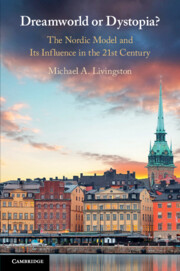
-
Select format
-
- Publisher:
- Cambridge University Press
- Publication date:
- December 2021
- December 2021
- ISBN:
- 9781108667432
- 9781108497312
- 9781108739788
- Dimensions:
- (229 x 152 mm)
- Weight & Pages:
- 0.392kg, 166 Pages
- Dimensions:
- (229 x 152 mm)
- Weight & Pages:
- 0.3kg, 166 Pages
You may already have access via personal or institutional login
Book description
The Nordic Model was originally understood as a compromise between Western and Soviet systems. The Soviet Union has been gone for a generation, but the Nordic Model survives. Much of this has to do with the Model's change from an economic to a largely cultural model. In particular the Model has come to emphasize human (especially women's) rights; environmental consciousness; and cultural innovation. While these each contain an element of fantasy, they retain sufficient substance to provide encouragement to 'progressive' circles in the United States, United Kingdom, and other countries. Important in its own right, the Nordic Model provides a fascinating case study of the transmission of goods and ideas between different regions, and the ability of a small and out of the way region to maintain its own identity in a globalized world.
Reviews
‘This book offers a refreshing view of the Nordic countries from an Anglo-American outlook … the author deserves praise for presenting both the pros and cons of the Nordic Model … as a cultural appetizer and an introduction to Nordic values and aspirations, it is a valuable and enjoyable read.’
Atle Midttun Source: Scandinavian Studies
‘Livingston makes a strong case for a broad Nordic Model …’
Eric S. Einhorn Source: Utopian Studies
Contents
Metrics
Altmetric attention score
Full text views
Full text views help Loading metrics...
Loading metrics...
* Views captured on Cambridge Core between #date#. This data will be updated every 24 hours.
Usage data cannot currently be displayed.
Accessibility standard: Unknown
Why this information is here
This section outlines the accessibility features of this content - including support for screen readers, full keyboard navigation and high-contrast display options. This may not be relevant for you.
Accessibility Information
Accessibility compliance for the PDF of this book is currently unknown and may be updated in the future.


